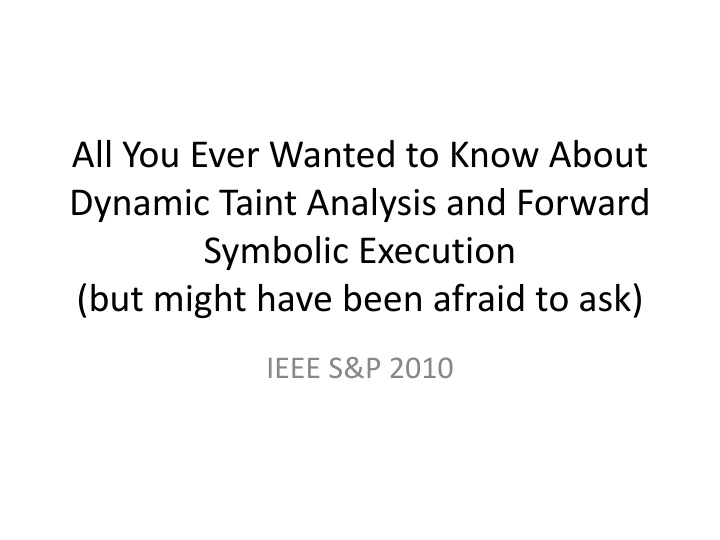
Dynamic Taint Analysis and Symbolic Execution in Cybersecurity
Delve into the precise algorithms of dynamic taint analysis and forward symbolic execution, essential for detecting vulnerabilities and generating test cases in cybersecurity. Explore the challenges, opportunities, and implementation choices outlined in the paper.
Download Presentation

Please find below an Image/Link to download the presentation.
The content on the website is provided AS IS for your information and personal use only. It may not be sold, licensed, or shared on other websites without obtaining consent from the author. If you encounter any issues during the download, it is possible that the publisher has removed the file from their server.
You are allowed to download the files provided on this website for personal or commercial use, subject to the condition that they are used lawfully. All files are the property of their respective owners.
The content on the website is provided AS IS for your information and personal use only. It may not be sold, licensed, or shared on other websites without obtaining consent from the author.
E N D
Presentation Transcript
All You Ever Wanted to Know About Dynamic Taint Analysis and Forward Symbolic Execution (but might have been afraid to ask) IEEE S&P 2010
Overview Two Main Contributions Precisely describe the algorithms for dynamic taint analysis and forward symbolic execution as extensions to the run-time semantics of a general language Highlight implementation choices, common pitfalls, other considerations in security context
Motivation Dynamic Taint Analysis and Forward Symbolic Execution (or a mix of the two) are important for Unknown Vulnerability Detection Automatic Input Filter Generation Malware Analysis Test Case Generation
Summary of the Paper A general language for formalization SIMPIL (Simple Intermediate Language) Operational Semantics Assembly like Missing high level language constructs Functions, buffers etc. Dynamic Taint Analysis Semantics Dynamic Taint Policies Semantics of Forward Symbolic Execution Challenges and Opportunities
Universal Intellectual Standards Clarity Accuracy Precision Relevance Depth Breadth Logic Significance Fairness
Clarity Clear Explanation of Operational Semantics Many examples throughout the paper The challenges are mentioned clearly in the paper but little clarity on how to proceed to solve them Section III-D does not elaborate on how to avoid time of detection vs time of attack problem
Accuracy Refers to prior work and provides a framework to explain it There are no results on soundness or completeness Dynamic Taint Policies (Under Tainting vs Over Tainting) Forward Symbolic Execution (Path Selection)
Precision Based on Operational Semantics of SimpIL Precise taint policies Better taint checking Explains symbolic execution in detail Not enough details on practical heuristics Handling difficult language features Path Exploration Symbolic Memory
Relevance Helps explain and understand taint analysis as used in practice from a theoretical perspective Does not add on much to the state of the art in actual algorithms or heuristics that can be used
Depth Focusses on operational semantics of SimpIL in depth to establish a common framework Does not expands on some of the practical ideas Sanitization problem Handling library and system code
Breadth Good coverage of all the aspects of taint analysis Some more information about use of static verification techniques as used in security analysis Symbolic Jumps Balakrishnan, G. and Reps, T., WYSINWYX: What You See Is Not What You eXecute. In ACM Trans. on Program. Lang. and Syst. 2009
Logic Step by step progression from operational semantics to taint checking and symbolic execution Lot of evidence in paper in form of references Not sufficient evaluation to see the benefit in using a operational semantics based approach to security analysis
Significance Explains practical security analysis from a theoretical framework Does not advance the state of art in taint analysis A survey of existing techniques No new uses of the operational semantics beyond what is already there in prior work
Fairness Good study on applying operational semantics in a security context From a programming language theory perspective Different taint policies should not create new operational semantics Semantics used to enforce policies
Thank You ! Questions ? Contact Asankhaya Sharma (A0068216E) asankhaya@nus.edu.sg
